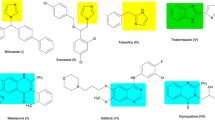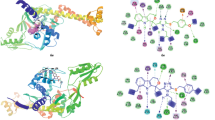Abstract
A series of substituted N-(quinolin-4-yl)ethanediamine phenyl urea derivatives of biological interest were prepared by sequential quinoline synthesis, chlorination, and substitution reaction followed by reaction of resulting amine with different aryl isocyanates. All synthesized compounds (1–13) were screened for their pro-inflammatory cytokines (TNF-α and IL-6) and antimicrobial activity (antibacterial and antifungal). Biological activity evaluation study revealed that among all the compounds screened, compounds 4 and 6 were found to have promising anti-inflammatory activity (up to 78–71 % TNF-α and 96–90 % IL-6 inhibitory activity) at a higher concentration of 10 μM with reference to standard dexamethasone (72 % TNF-α and 86 % IL-6 inhibitory activities at 1 μM). Compounds 6, 8, 10, and 11 overall exhibited promising antimicrobial activity at MIC values ranging from 10 to 30 μg/mL against all the selected pathogenic bacteria and fungi.

Similar content being viewed by others
References
Candéa ALP, Ferreira MDL, Pais KC, Cardoso LNF, Kaiser CR, Das M, Henriques GM, Lourenço MCS, Bezerra FAFM, De Souza MVN (2009) Synthesis and antitubercular activity of 7-chloro-4-quinolinylhydrazones derivatives. Bioorg Med Chem Lett 19:6272–6274
De Souza MVN, Pais KC, Kaiser CR, Peralta MA, Ferreira ML, Lourenço MCS (2009) Synthesis and in vitro antitubercular activity of a series of quinoline derivatives. Bioorg Med Chem 17:1474–1480
Denny WA, Wilson WR, Ware DC, Atwell GJ, Milbank JB, Stevenson RJ (2006) US Patent 7064117
Dominic SC, Raj MD (2009) Role of interleukin-6 in the anemia of chronic disease. Semin Arthritis Rheum 38:382–388
Ekoue-Kovi K, Yearick K, Iwaniuk DP, Natarajan JK, Alumasa J, de Dios AC, Roepe PD, Wolf C (2009) Synthesis and antimalarial activity of new 4-amino-7-chloroquinolyl amides, sulfonamides, ureas and thioureas. Bioorg Med Chem 17:270–283
Eswaran S, Adhikari AV, Shetty NS (2009) Synthesis and antimicrobial activities of novel quinoline derivatives carrying 1,2,4-triazole moiety. Eur J Med Chem 44:4637–4647
Gable KL, Maddux BA, Penaranda C, Zavodovskaya M, Campbell MJ, Lobo M, Robinson L, Schow S, Kerner JA, Goldfine ID, Youngren JF (2006) Diaryl ureas are small-molecule inhibitors of insulin-like growth factor I receptor signaling and breast cancer cell growth. Mol Cancer Ther 5:1079–1086
Hwang C, Gatanaga M, Granger GA, Gatanaga T (1993) Mechanism of release of soluble forms of tumor necrosis factor/lymphotoxin receptors by phorbol myristate acetate-stimulated human THP-1 cells in vitro. J Immunol 151:5631–5638
Ilovich O, Jacobson O, Aviv Y, Litchi A, Chisin R, Mishani E (2008) Formation of fluorine-18 labeled diaryl ureas labeled VEGFR-2/PDGFR dual inhibitors as molecular imaging agents for angiogenesis. Bioorg Med Chem 16:4242–4251
Izumi T, Sakaguchi J, Takeshita M, Tawara H, Kato K, Dose H, Tsujino T, Watanabe Y, Kato H (2003) 1H-imidazo[4,5-c]quinoline derivatives as novel potent TNF suppressors: synthesis and structure-activity relationship of 1-, 2-and 4-substituted 1H-imidazo[4,5-c]quinoline or 1H-imidazo[4,5-c]pyridines. Bioorg Med Chem 11:2541–2550
Keche AP, Hatnapure GD, Tale RH, Rodge AH, Birajdar SS, Kamble VM (2012) A novel pyrimidine derivatives with aryl urea, thiourea and sulfonamide moieties: synthesis, anti-inflammatory and antimicrobial evaluation. Bioorg Med Chem Lett 22:3445–3448
Krishnamoorthy S, Honn KV (2006) Inflammation and disease progression. Cancer Metastasis Rev 25:481–491
Kubo K, Shimizu T, Ohyama S, Murooka H, Iwai A, Nakamura K, Hasegawa K, Kobayashi Y, Takahashi N, Takahashi K, Kato S, Izawa T, Isoe T (2005) Novel potent orally active selective VEGFR-2 tyrosine kinase inhibitors: synthesis, structure activity relationships and antitumor activities of N-phenyl-N ¢-{4-(4-quinolyloxy) phenyl ureas. J Med Chem 48:1359–1366
LaMontagne MP, Markovac A, Khan MS (1982a) Antimalerial. 13. 5-Alkoxy analogs of 4-methylprimaquine. J Med Chem 25:964–968
LaMontagne MP, Blumbergs P, Strube RE (1982b) Antimalerial. 14. 5-(aryloxy)-4-methylprimaquine analogs. A highly effective series of blood and tissue schizonticidal agents. J Med Chem 25:1094–1097
Leatham PA, Bird HA, Wright V, Seymour D, Gordon A (1983) A double blind study of antrafenine, naproxen and placebo in osteoarthrosis. Eur J Rheumatol Inflamm 6:209–211
Madrid PB, Sherrill J, Lio AP, Weisman JL, DeRisi JL, Guya RK (2005) Synthesis of ring-substituted 4-aminoquinolines and evaluation of their antimalerial activities. Bioorg Med Chem Lett 15:1015–1018
Maguire MP, Sheets KR, McVety K, Spada AP, Zilberstein A (1994) A new series of PDGF receptor tyrosine kinase inhibitors: 3-substituted quinoline derivatives. J Med Chem 37:2129–2137
Mahamoud A, Chevalier J, Davin-Regli A, Barbe J, Pages J (2006) Quinoline derivatives as promising inhibitors of antibiotic efflux pump in multidrug resistant Enterobacter aerogenes isolates. Curr Drug Targets 7:843–847
Metwally KA, Abdel-Aziz LM, Lashine EM, Husseiny MI, Badawya RH (2006) Hydrazones of 2-aryl-quinoline-4-carboxylic acid hydrazides: synthesis and preliminary evaluation as antimicrobial agents. Bioorg Med Chem 14:8675–8682
Muruganantham N, Sivakumar R, Anbalagan N, Gunasekaran V, Leonard JT (2004) Synthesis, anticonvulsant and antihypertensive activities of 8-substituted quinoline derivatives. Biol Pharm Bull 27:1683–1687
Nasveld P, Kitchener S (2005) Treatment of acute vivax malaria with tafenoquine. Trans R Soc Trop Med Hyg 99:2–5
Papadakis KA, Targan SR (2000) The role of chemokines and chemokine receptors in mucosal inflammation. Inflamm Bowel Dis 6:303–313
Praveen C, DheenKumar P, Muralidharan D, Perumal PT (2010) Synthesis, antimicrobial and antioxidant evaluation of quinoline and bis(indolyl)methanes. Bioorg Med Chem Lett 20:7292–7296
Sridhar R, Perumal PT, Etti S, Shanmugam G, Ponnuswamy MN, Prabavathyc VR, Mathivanan N (2004) Design, synthesis and anti-microbial activity of 1H-pyrazole carboxylates. Bioorg Med Chem Lett 14:6035–6040
Stocks PA, Raynes KJ, Bray PG, Park BK, O’Neill PM, Ward SA (2002) Novel short chain chloroquine analogues retain activity against chloroquine resistant K1 Plasmodium falciparum. J Med Chem 45:4975–4985
Strekowski L, Mokrosz JL, Honkan VA, Czarny A, Cegla MT, Patterson SE, Wydra RL, Schinazi RF (1991) Synthesis and quantitative structure-activity relationship analysis of 2-(aryl or heteroaryl)quinolin-4-amines, a new class of anti-HIV-1 agents. J Med Chem 34:1739–1746
Sunduru N, Sharma M, Srivastava K, Rajakumar S, Puri SK, Saxena JK, Chauhan PMS (2009) Synthesis of oxalamide and triazine derivatives as a novel class of hybrid 4-aminoquinoline with potent antiplasmodial activity. Bioorg Med Chem 17:6451–6462
Tale RH, Rodge AH, Hatnapure GD, Keche AP (2011) The novel 3,4-dihydropyrimidin-2(1H)-one urea derivatives of N-aryl urea: synthesis, anti-inflammatory, antibacterial and antifungal activity evaluation. Bioorg Med Chem Lett 21:4648–4651
Tale RH, Rodge AH, Hatnapure GD, Keche AP, Patil KP, Pawar RP (2012) The synthesis, anti-inflammatory and antimicrobial activity evaluation of novel thioanalogs of 3,4-dihydrothiopyrimidin-2(1H)-one derivatives of N-aryl urea. Med Chem Res. doi:10.1007/s00044-011-9943-3
Thomas KD, Adhikari AV, Shetty NS (2010) Design, synthesis and antimicrobial activities of some new quinoline derivatives carrying 1,2,3-triazole moiety. Eur J Med Chem 45:3803–3810
Wilson WD, Zhao M, Patterson SE, Wydra RL, Janda L, Strekowski L, Schinazi RF (1992) Design of RNA interactive anti-HIV-1 agents: unfused aromatic intercalators. Med Chem Res 2:102–110
Wu J, Green N, Hotchandani R, Hu Y, Condon J, Huang A, Kaila N, Li H, Guler S, Li W, Tam SY, Wang Q, Pelker J, Marusic S, Hsu S, Hall JP, Telliez J, Cui J, Lin L (2009) Selective inhibitors of tumor progression loci-2 (Tpl2) kinase with potent inhibition of TNF-α production in human whole blood. Bioorg Med Chem Lett 19:3485–3488
Yasui H, Hideshima T, Ikeda H, Jin J, Ocio EM, Kiziltepe T, Okawa Y, Vallet S, Podar K, Ishitsuka K, Richardson PG, Pargellis C, Moss N, Raje N, Anderson KC (2007) BIRB 796 enhances cytotoxicity triggered by bortezomib, heat shock protein (Hsp) 90 inhibitor, and dexamethasone via inhibition of p38 mitogen-activated protein kinase/Hsp27 pathway in multiple myeloma cell lines and inhibits paracrine tumour growth. British J Haematol 136:414–423
Acknowledgments
The authors would like to thank Mr. R.B. Ingle, Department of Microbiology, Shri Shivaji Collage, Akola for biological screening studies of the newly synthesized compounds.
Author information
Authors and Affiliations
Corresponding author
Rights and permissions
About this article
Cite this article
Keche, A.P., Hatnapure, G.D., Tale, R.H. et al. Synthesis, anti-inflammatory and antimicrobial evaluation of novel N1-(quinolin-4yl)ethane-1,2-diamine phenyl urea derivatives. Med Chem Res 22, 1480–1487 (2013). https://doi.org/10.1007/s00044-012-0144-5
Received:
Accepted:
Published:
Issue Date:
DOI: https://doi.org/10.1007/s00044-012-0144-5




